Come and See the Lava -- Big Island Hawaii
By Bob Starink
The Big Island of Hawaii doesn’t have the glitz of Oahu but it does have the volcano. Kilauea, with its ongoing lava flows, is a major enticement away from the beaches of Honolulu.
We stayed in Hilo, the capital and closest city from which to visit Volcanoes National Park. We opted for a morning helicopter flight to study the big picture before heading out by car at ground level. We also went with the Doors-off Experience, the idea here being that you can actually feel the heat coming from below as you fly.Let me say it’s a very small helicopter (the pilot, two more in the front and two in the back). I had the prime position up front but I’ll admit it was unnerving having a whole bum cheek hanging out the side flying over 3,000 feet above the ground. Also, while the copter is definitely worth the $225 per person, you are at the mercy of the volcano’s whims. While naturally not wishing anyone harm, you do hope for lava spurting into the sky and rivers of red flows gushing down the slopes. You might fluke this happening, but more likely you will have a slow day like we did. You will see lots of steam but very little red. The magnitude of the volcanic country is impressive, though, and you will definitely appreciate the activity you do see from such a fine vantage point.
Back at the airport, it’s into the rental car (very necessary here) and off to explore. Volcanoes National Park is 40 minutes from Hilo and offers many walks around and into craters. A short walk through the Thurston Lava Tube demonstrates what is happening elsewhere on an active scale. The drive down Chain of Craters Road to the coast covers vast lava fields and continues till the road stops where it has been cut by previous lava flows. A lookout over the water here shows the craggy coastline and a lava arch. There is a long walk into the distance along the coastline which we knew from the helicopter would not be worth the hours it would take.
We ventured down the less touristy Route 130 through Pahoa to check out the other end of the road that stops. This ended up being a good move. From a parking area, local volunteers tell you what’s happening further down the road. That day there was a fresh lava breakout. The 20-minute walk had more to see than the lava at the end of it. There are occupied houses built on the lava fields, strange structures often surrounded by only black rock. The insurance premiums here must be extreme. (One was for sale. No thanks.) We reached the breakout, and from a safe distance we witnessed fresh lava seething to the surface, causing bushes to catch alight and flowing (very slowly) in our direction, the molten bright silver rock as it cooled a living contrast to the rough dead crusts evident on the walk there.
Take the scenic route along the coast going back to Hilo and see a greener part of the island with pretty houses you may really be tempted to buy.
While on the Big Island, we also participated in a quad bike tour with ATV Outfitters on the North Kohala coast. If you have time, this is an exciting excursion riding over farmland, through gulches and up and down hills to see a more inviting shoreline. They also offer tours into the hills for a swim beneath a waterfall in a mountain pool.
If you go:
Jetstar offers cheap flights to Hawaii from $500 one way. Honolulu to Hilo with Hawaiian Airlines is around $80 including taxes. Volcanoes National Park costs $10 per car entry. A seaside ATV tour is priced at $129 per person and takes just under two hours. Hilo is on the wet side of the island with the ritzy resorts all on the dryer, far side near Kona, so accommodation in Hilo is basic. We stayed at the Dolphin Bay Hotel, not flash but clean and comfortable for $125 per night.
For more information see www.paradisecopters.com and www.atvoutfittershawaii.com.
 You are touring the Haigh’s Chocolates factory, established in 1915 and just five minutes from Adelaide city center in South Australia. The tempo increases with the fragrance as you enter the free tasting area. Chocolate frogs, fruit centers, truffles, fudges and bars! Sparkling glass counters contain trays of mouth-watering, exquisitely-decorated delights. While savoring a rich, polished liqueur center, you are already eye-balling a powdered chocolate truffle. Tucking a large pack of chocolate truffle seconds (cheapskate?) into your pocket, you depart for the city coach tour.
You are touring the Haigh’s Chocolates factory, established in 1915 and just five minutes from Adelaide city center in South Australia. The tempo increases with the fragrance as you enter the free tasting area. Chocolate frogs, fruit centers, truffles, fudges and bars! Sparkling glass counters contain trays of mouth-watering, exquisitely-decorated delights. While savoring a rich, polished liqueur center, you are already eye-balling a powdered chocolate truffle. Tucking a large pack of chocolate truffle seconds (cheapskate?) into your pocket, you depart for the city coach tour. A planned “square mile” grid is the layout for Adelaide, which was founded for free settlers in 1836. Broad parklands on all sides are a defensive measure around a low-rise city. Wide boulevards and squares offset gracious Victorian sandstone buildings. The Torrens River meanders by. Wonderfully diverse food markets lead off Victoria Square and it’s the perfect spot to pick up a cheap lunch of fruits, cheeses, bread, nuts and cold meats.
A planned “square mile” grid is the layout for Adelaide, which was founded for free settlers in 1836. Broad parklands on all sides are a defensive measure around a low-rise city. Wide boulevards and squares offset gracious Victorian sandstone buildings. The Torrens River meanders by. Wonderfully diverse food markets lead off Victoria Square and it’s the perfect spot to pick up a cheap lunch of fruits, cheeses, bread, nuts and cold meats. Next day you’re on a coach to the Adelaide Hills and the wine-producing Barossa Valley. Jacob’s Creek Winery boasts an expansive tasting room and restaurant with high glass walls. At the time of our visit, mellow views stretched over the colorful autumnal vineyards on the rolling hills. The winery is a major exporter of reds and whites, but the sampling glasses are far too small!
Next day you’re on a coach to the Adelaide Hills and the wine-producing Barossa Valley. Jacob’s Creek Winery boasts an expansive tasting room and restaurant with high glass walls. At the time of our visit, mellow views stretched over the colorful autumnal vineyards on the rolling hills. The winery is a major exporter of reds and whites, but the sampling glasses are far too small!
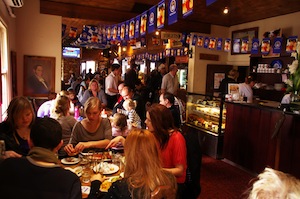 In the rolling green Adelaide Hills you discover a lovely small town built of colored stone. In 1839 German settlers founded Hahndorf. The architecture is Germanic, the climate Mediterranean. And meals are heavenly at the Hahndorf Inn.
In the rolling green Adelaide Hills you discover a lovely small town built of colored stone. In 1839 German settlers founded Hahndorf. The architecture is Germanic, the climate Mediterranean. And meals are heavenly at the Hahndorf Inn. How do you find this gem? The Crozon peninsula is an easy 45-minute drive from the city of Brest. And Brest is only an hour’s flight from Paris (or a four-hour train ride if you prefer). Renting a car and getting over is easy on a great expressway and you’ll enjoy seeing signs always translated in the local Breton language.
How do you find this gem? The Crozon peninsula is an easy 45-minute drive from the city of Brest. And Brest is only an hour’s flight from Paris (or a four-hour train ride if you prefer). Renting a car and getting over is easy on a great expressway and you’ll enjoy seeing signs always translated in the local Breton language. It’s lunchtime and you have comfortable seating in the timber-paneled “Queen Adelaide” dining car on the only major train journey in the world that travels north-south across a continent. You boarded “The Ghan” in Darwin in the “Top End,” and two sleeps, 1,847 miles, and a few deserts later you’ll enter Adelaide on the Great Australian Bight.
It’s lunchtime and you have comfortable seating in the timber-paneled “Queen Adelaide” dining car on the only major train journey in the world that travels north-south across a continent. You boarded “The Ghan” in Darwin in the “Top End,” and two sleeps, 1,847 miles, and a few deserts later you’ll enter Adelaide on the Great Australian Bight.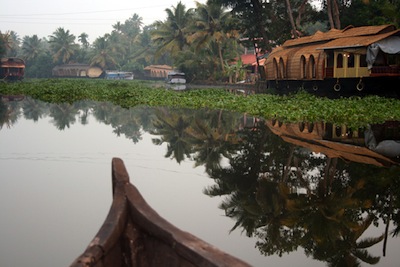 For travelers wanting to experience the tranquil and exceedingly beautiful backwaters of Kerala in India there are affordable alternatives to hiring a houseboat. While there are hundreds of kettuvallams (houseboats) available for rent for any period from three hours up to a week or more, this option is expensive and beyond the reach of most independent travelers on a budget. Just as importantly, the backwaters around Alleppey are packed with tourists and the converted rice barges are too wide to enter the tiny canals which are the center of village life on the backwaters.
For travelers wanting to experience the tranquil and exceedingly beautiful backwaters of Kerala in India there are affordable alternatives to hiring a houseboat. While there are hundreds of kettuvallams (houseboats) available for rent for any period from three hours up to a week or more, this option is expensive and beyond the reach of most independent travelers on a budget. Just as importantly, the backwaters around Alleppey are packed with tourists and the converted rice barges are too wide to enter the tiny canals which are the center of village life on the backwaters.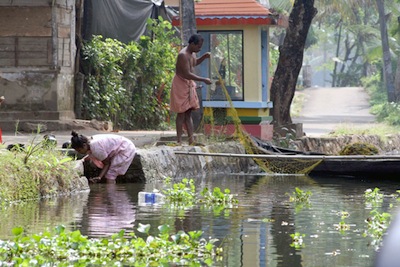 The banks of the canals are constantly busy. Depending on the time of day, locals will be cleaning their teeth, washing their clothes, and rinsing their cooking utensils. The young men throw fishing nets while the older men idly cast their lines into the dark water. Small huts along the banks offer freshly grilled fish and shellfish. The boat ride passes paddy fields, small farms, mangrove swamps and groves of coconuts. Eventually the boat emerges on to Lake Vembanad, and skirts the shores before returning to the Kumarakom jetty.
The banks of the canals are constantly busy. Depending on the time of day, locals will be cleaning their teeth, washing their clothes, and rinsing their cooking utensils. The young men throw fishing nets while the older men idly cast their lines into the dark water. Small huts along the banks offer freshly grilled fish and shellfish. The boat ride passes paddy fields, small farms, mangrove swamps and groves of coconuts. Eventually the boat emerges on to Lake Vembanad, and skirts the shores before returning to the Kumarakom jetty.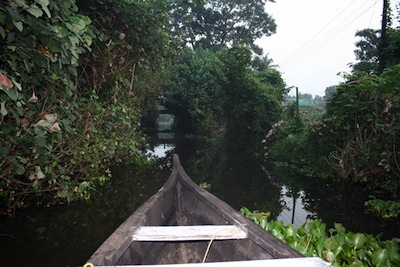 Kumarakom is also home to a bird sanctuary. The reserve covers more than 14 acres of forest and waterways. Between March and November it is home to many species of migratory birds, including storks, from Siberia. The best way to experience the bird life is to see it from outside the sanctuary, from the water. The fact is that the birds don’t know it is a sanctuary so outside of the nesting season they are more readily seen from the lake and canals.
Kumarakom is also home to a bird sanctuary. The reserve covers more than 14 acres of forest and waterways. Between March and November it is home to many species of migratory birds, including storks, from Siberia. The best way to experience the bird life is to see it from outside the sanctuary, from the water. The fact is that the birds don’t know it is a sanctuary so outside of the nesting season they are more readily seen from the lake and canals.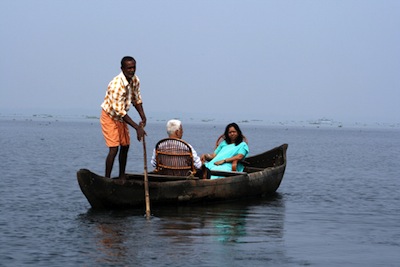 The simplest way to see the birds is to go to the bird sanctuary entrance, but do not purchase an entry ticket. Outside the sanctuary a dozen or so guides will be offering their services. You can pick up a guide for 250 rupees an hour (about fifty cents). He will pole you in a narrow wooden canoe through the tiny waterways bordering the sanctuary and onto Lake Vembanad itself. Birds are in abundance -- waterfowl, darters, woodpeckers, kingfishers, cuckoos, herons, waders, cormorants, ducks, and many more. On the lake curious otters pop their heads up to inspect the canoeists.
The simplest way to see the birds is to go to the bird sanctuary entrance, but do not purchase an entry ticket. Outside the sanctuary a dozen or so guides will be offering their services. You can pick up a guide for 250 rupees an hour (about fifty cents). He will pole you in a narrow wooden canoe through the tiny waterways bordering the sanctuary and onto Lake Vembanad itself. Birds are in abundance -- waterfowl, darters, woodpeckers, kingfishers, cuckoos, herons, waders, cormorants, ducks, and many more. On the lake curious otters pop their heads up to inspect the canoeists.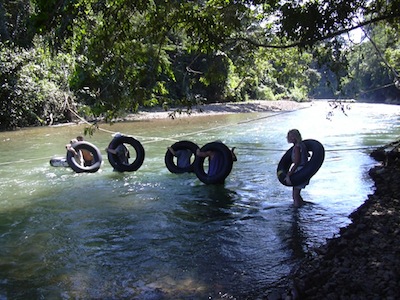 Grab your tube and water shoes and get ready for a true wet ’n’ wild adventure -- a journey that starts with a mostly uphill jungle trek hauling your own professional-grade inflatable tube and includes fording a portion of the beautiful, green Caves Branch River.
Grab your tube and water shoes and get ready for a true wet ’n’ wild adventure -- a journey that starts with a mostly uphill jungle trek hauling your own professional-grade inflatable tube and includes fording a portion of the beautiful, green Caves Branch River.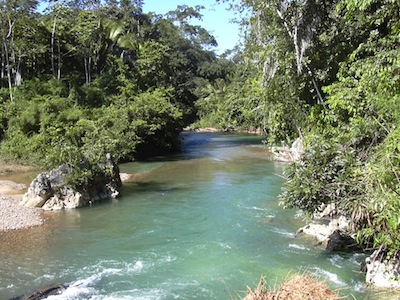 Around 40 minutes into the hike, your sweat-drenched body is rewarded with the refreshing sight of the entrance point where you will plunge into the depths of the chilly river to explore the cave system. The caves were carved out of the foothills of the Maya Mountain by the powerful force of water over thousands of years. Gliding in a human chain through currents intermittent with small rapids, you’ll meander lazy-river style, dipping and swishing and lunging through an underworld of interconnecting limestone caves with only your tube beneath you and a headlight to illuminate your path. Your guide will point out waterfalls, ancient ritual chambers, myriad stalagmites and stalactites and unique cave formations. But no matter how awed, be sure to keep your mouth closed, because there are bats hanging above your head!
Around 40 minutes into the hike, your sweat-drenched body is rewarded with the refreshing sight of the entrance point where you will plunge into the depths of the chilly river to explore the cave system. The caves were carved out of the foothills of the Maya Mountain by the powerful force of water over thousands of years. Gliding in a human chain through currents intermittent with small rapids, you’ll meander lazy-river style, dipping and swishing and lunging through an underworld of interconnecting limestone caves with only your tube beneath you and a headlight to illuminate your path. Your guide will point out waterfalls, ancient ritual chambers, myriad stalagmites and stalactites and unique cave formations. But no matter how awed, be sure to keep your mouth closed, because there are bats hanging above your head! 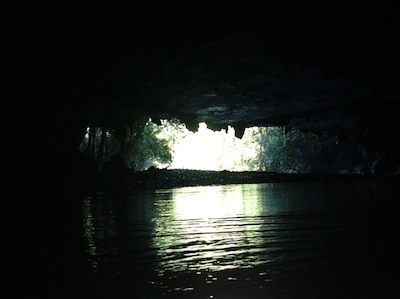 Darkness. Extreme, utter, complete darkness accompanied first by eerie silence, then by gasps of amazement. Vertigo begins to envelop you as sensory deprivation of position and direction prevails.
Darkness. Extreme, utter, complete darkness accompanied first by eerie silence, then by gasps of amazement. Vertigo begins to envelop you as sensory deprivation of position and direction prevails. Lucky for me, I found it, in a very unlikely place. Ko-Ox-Han-Nah (which means “Let’s Go Eat!” in Mayan) is one of the most well-known restaurants in the Cayo District (they’re number one on Trip Advisor), and you can’t come to San Ignacio Town, or Santa Elena, its sister town, without dining on their authentic Belizean fare. However, what most people don’t know is that catty-corner across the street, they also have a deli, bistro, and meat shop by the same name, where the food, service, and atmosphere are just as good, but with more of an American culinary spin.
Lucky for me, I found it, in a very unlikely place. Ko-Ox-Han-Nah (which means “Let’s Go Eat!” in Mayan) is one of the most well-known restaurants in the Cayo District (they’re number one on Trip Advisor), and you can’t come to San Ignacio Town, or Santa Elena, its sister town, without dining on their authentic Belizean fare. However, what most people don’t know is that catty-corner across the street, they also have a deli, bistro, and meat shop by the same name, where the food, service, and atmosphere are just as good, but with more of an American culinary spin. As the boat slowly glides through the waters of Lake Thun, you admire the stunning scenery from the deck while enjoying a snack and a cup of coffee, or a glass of wine. It is a balmy summer afternoon; a few clouds linger over the snow-capped mountains of the Niederhorn range. It is astonishing -- you can clearly see the snow on the high mountains, but they seem so far away. Here on the lake it is warm. A slight breeze mitigates the summer heat. The lake is calm and its blue, tranquil waters have a soothing effect. From time to time the musical note of the boat’s horn announces a stop at one of the many picturesque towns along the lake. A few people disembark, others come aboard, and minutes later your journey continues.
As the boat slowly glides through the waters of Lake Thun, you admire the stunning scenery from the deck while enjoying a snack and a cup of coffee, or a glass of wine. It is a balmy summer afternoon; a few clouds linger over the snow-capped mountains of the Niederhorn range. It is astonishing -- you can clearly see the snow on the high mountains, but they seem so far away. Here on the lake it is warm. A slight breeze mitigates the summer heat. The lake is calm and its blue, tranquil waters have a soothing effect. From time to time the musical note of the boat’s horn announces a stop at one of the many picturesque towns along the lake. A few people disembark, others come aboard, and minutes later your journey continues. Congratulate yourself for having chosen to come to Spiez instead of one of the more well-known -- but rather crowded -- tourist areas in Switzerland. Located at the south bank of Lake Thun (Thunersee), this delightful small town is less than 45 minutes by train from Bern, the capital of Switzerland. The population is about 12,000 and the altitude is less than 2,000 feet. It doesn’t have a great nightlife, but it offers first-class hotels and restaurants, and an array of daytime activities.
Congratulate yourself for having chosen to come to Spiez instead of one of the more well-known -- but rather crowded -- tourist areas in Switzerland. Located at the south bank of Lake Thun (Thunersee), this delightful small town is less than 45 minutes by train from Bern, the capital of Switzerland. The population is about 12,000 and the altitude is less than 2,000 feet. It doesn’t have a great nightlife, but it offers first-class hotels and restaurants, and an array of daytime activities. Spiez has many scenic trails, some more strenuous than others. You could take a leisurely stroll on the Strandweg (“walk along the beach”) towards Faulensee, an easy walk of less than two miles that will take you along the lakeside, under tall trees and across open spaces. Waterfowl such as swans and common mergansers abound. Sit on a bench and let your gaze wander from the lake to the impressive Morgenberghorn and the trio of the Eiger, Mönch and Jungfrau mountains; or watch the sailboats and ships tracing their ways on the lake.
Spiez has many scenic trails, some more strenuous than others. You could take a leisurely stroll on the Strandweg (“walk along the beach”) towards Faulensee, an easy walk of less than two miles that will take you along the lakeside, under tall trees and across open spaces. Waterfowl such as swans and common mergansers abound. Sit on a bench and let your gaze wander from the lake to the impressive Morgenberghorn and the trio of the Eiger, Mönch and Jungfrau mountains; or watch the sailboats and ships tracing their ways on the lake.